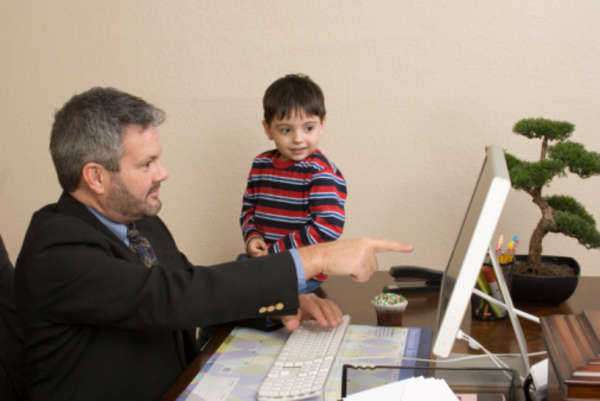
Since a child is kept in the family, albeit not in their immediately family, it is generally assumed that the decision for a grandparent or other relative to bring a child into his or her home is the next best thing to putting up a child for adoption. For all the benefits kinship care may provide a child, though, it may do harm to the family in the process.
First of all, though people unfamiliar with the adoptive kin setup might think kinship adoption is a natural consequence of relative-minor child family units, oftentimes a grandparent, aunt or other extended family member will not feel the need to formally adopt a child or will not qualify for benefits, opting to merely take custody of the child without the safety net of a more permanent arrangement. Worse yet, with a grandparent or other relative as caretaker, there may be less incentive for a parent to earn back parental rights if they are afforded visitation, or that birth parent might come to resent the family member who is raising his or her offspring.
Adoption Process
While first-time adopters may not have given much thought to the steps involved in the adoption process, adoption agency workers and veterans of adoption would likely insist that they are something to be taken seriously, especially given the policies of individual states and countries that make defining an exact process hard, if not impossible.
Finding out which government authority has control of adoption in your jurisdiction and which private agencies are accredited, reliable organizations is an important first step leading up to the adoption, as well as researching said State and international laws on adoption. The decision of whether or not to go abroad itself may be one that needs to be made, and in that event, the country of origin and even race of a potential adoptee might be more than just an oversight.
As fundamental as these choices might be on who adopters want to work with and what kinds of children they wish to adopt, a public or private agency still has to decide to work with a family. If they are deemed suitable to adopt, there should theoretically be little concern. Just the same, all prospective adoptive parents and any preexisting children must take part in an adoption home study.
Moreover, all of the above does not even take into account the need to match a child with a family, place that child in the family and legally complete the adoption.
Adoption Laws
In just a short amount of time, a number of significant policies impacting adoption in the United States have been enacted at both the Federal and State level. In terms of Federal legislation, the laws have evolved with shifts in national attitudes toward keeping kids out of the child welfare system. The Adoption Assistance and Child Welfare Act of 1980 Adoption, and Family Services Act of 1992 are all examples of such legislation. Of course, these are pieces of legislation that are more broad in scope.
For seeing how Federal funds will actually be implemented and which kinds of people are actually eligible to adopt, it is up to State statutes to decide what is permissible within their own boundaries. Thus, to a large extent domestic adoption is contingent on the policies of the states. More often, while Federal policies will determine which children qualify for benefits, State guidelines will determine which adults qualify to be adoptive parents.
Depending on the jurisdiction, individuals might be disqualified from raising non-relative children if they are, say, too young, unmarried, or LGBT applicants. Meanwhile, in the special case of a child’s surrender to a safe haven, both a parent’s eligibility to legally and confidentially waive his or her parental rights (sometimes, only birth mothers are offered this privilege) and a child’s viability for abandonment (children older than three days may not be acceptable according to State mandate) may be subject to State interpretation.
Adoption agencies are the means by which potentially adoptive parents can adopt their children. Adoption agencies can take many different forms, ranging from State-based adoptive agencies, which primarily focus on children in foster care, to Christian adoptive agencies.
Adoption Statistics
Though the practices of domestic and international adoption are common enough, the inclusion of adoption statistics in regularly-issued official reports is not as common, and within the United States, only recently have population statisticians like census takers seen fit to include adoption data in their surveys. Historically, the very notion of adoption as a legally-binding institution was not even contemplated until the 1850s, and the history of a Federal agency with oversight of adoption statistics is confined to less than half a century.
Today, we have a better idea about adoption trends in America thanks to universities and independent researchers who have compiled the data, but even so, a lot of figures put forth are estimates based on tallies volunteered by the states and dating from more than five years ago.
From what we do know, though, we can make educated guesses about how adoption manifests itself today and where it is going in the future. In terms of country-wide trends, adoption as a whole has seen its ups and downs, though special needs adoption, for one, has seen steady increases over time. International adoption, meanwhile, is down from its peak performance in the 1970s, and has nosedived as of late.
Adoption Resources
Accurate information on adoption can never be overvalued considering adoption has been analyzed from many opposing viewpoints in the past, so many Americans even today have such profound misconceptions about the practice. In fact, adoption has had to recover from the insistence by scientists that birth parents are necessary for a child’s proper maturation, while other myths, such as the one that suggests being raised by homosexuals can “turn a child gay” could use some debunking.
For prospective adoptive parents, a number of valuable traditional resources are at their disposal. There are a lot books about adoption lining the shelves of libraries and bookstores that may answer questions a person might have about adoption, right down to colorful and informative books for children. Adoption centers with physical addresses and State Social Services departments that process domestic public adoptions may also shed some light on the adoption process via free consultations or brochures on adoption.
Then again, since the mid 1990s, the Internet has been a burgeoning source of information on adoption. Today, several popular forms of online communication are useful for gathering information on the adoption process.
Probably the most recognizable of Web-based research methods to casual computer users is that of websites from official adoption organizations, whether they are public agencies (State foster care services, AdoptUsKids initiative), private agencies (e.g. Cradle of Hope Adoption Center), non-profit adoption resource centers (e.g., National Adoption Center), or other foundations that direct adoptive parents to relief through grant monies.
Parents are also recommended to consult community-based adoption forums and adoption-related blogs for more personal stories and viewpoints on the subject. In the future, social networking among adoptive parents will likely play a major role in providing support for tech-savvy stay-at-home adoptive moms and dads.
Special Needs Adoption
Though statistics would indicate special needs adoption is on the rise and more special needs adoptions from foster care work out than not, adoption in itself is a serious undertaking and classification of a child with special needs makes things that much more complicated. State definitions for which children can be considered special needs adoptees may vary decidedly, though regardless, even the most seemingly banal of “special needs” (e.g. African-American heritage) may put a child at risk of genetic defects and make him or her a target of persecution and ridicule.
Moreover, there is a high degree of coincidence between life in foster care and development/worsening of the severity of disabilities and other conditions, so adoptive parents must ready their homes, their routines and their very mindsets to accommodate children who will be dependent on their care.
Plus, there are other challenges surrounding special needs adoption, including logistical concerns. For example, a single parent may find it difficult to manage a child with special needs on top of a full-time job, and insurance alone may not cover all of a child’s medical costs given more chronic, severe handicaps.
For all the apparent emotional obstacles adoptive parents may have to overcome in their pursuit of adopting a child with special needs, the help they receive from outsiders and the love they receive from that child may be well worth the occasional setbacks.
With specific regard to the objective tangible benefits of special needs adoption, seeing as so many children with special needs come from the child welfare system, public agencies may not even require any money upfront for adoptive parents to bring a child into their homes and may not even need adopters to be rich, married or even homeowners. Also, going back to the high costs of healthcare, Federal and State subsidies may be able to defray the cost of living provided the child is eligible.
Adoption of Older Children
To be fair, the “adoption of older children” umbrella takes a fairly wide range of ages into account, but considering the high demand for infant children from American prospective adoptive parents, this category may be a valid one, if slightly unwieldy. To help with this, some agencies and amateur taxonomists might break down this group further into toddler and adolescent/teen adoption.
Toddler adoption, as somewhat of a happy medium between infant and teen adoption, may be rewarding for parents who wish to adopt young while still saving on the total cost of adoption. Adolescent and teen adoption, meanwhile, might prove advantageous to adoptive parents who feel they would make a better parent for older children than babies, or those who don’t want to have to worry as much about the decision of a biological parent.
Of course, the adoption of any older child from public welfare has its critical implications. Developmentally, these children are naturally at stages where rebellion against authority is practically their raison d’être, and by virtue of this, raising adopted children can emotionally feel like a battle at times. This may be especially challenging during the adolescent years, when peer pressure and concerns about one’s image will force children to make some realistically tough decisions about what to do to fit in and what not to do to stay safe.
In addition, regardless of whether or not they are five or fifteen, children may feel conflicted when they think back to life with their birth families. For some, being separated from their biological parents can be a recent phenomenon, and thus, very emotionally raw for them, regardless of how well they might be treated by their adoptive parents. It may take much “work” and quality bonding time between adoptive parents and adoptees before children start to conceptualize the strangers that adopted them as family.
LGBT Adoption
Adoption of children by gay, lesbian, bisexual and transgender couples or some variation thereof is one of the most hotly debated issues in adoption because people have such divisive views about homosexuality and what that means for the best interests of American children. In fact, the general public is basically split 50-50 on whether or not gays, et al, should be allowed to adopt at all.
To date, though President George W. Bush and others have pushed for a constitutional amendment outlawing gay marriage, there is no binding resolution in the United States against adoption by homosexual couples. By the same token, however, adoption eligibility is usually decided by the states and few states have explicitly granted LGBT applicants full rights to adopt.
To be sure, lack of a policy banning gays and lesbians from child adoption is not the same thing as positively affirming their rights. This is most apparent in cases of interstate adoption where authorities have refused to legally acknowledge adoptions because they brought a child over from a State where LGBT adoption is outlawed.
Some states, meanwhile, ban LGBT adoption explicitly, with Florida being the one State to legislate against adoption by openly gay applicants, even those who would be single parents. Consequently, the Sunshine State has become iconic in the struggle for/against LGBT adoptive rights. Once again, the Federal Government has been largely silent on the issue, but at the local and State levels and among advocacy groups, the fight is an enduring one.
Anti-LGBT reformers call for more expansive laws against gay couple seeking to adopt, under the mindset that homosexuality is a corruptive, immoral force. Pro-LGBT reformers, meanwhile, supported by nationally recognized groups like the ACLU, GLAAD and Lambda Legal, push for State-by-State repeals of discriminatory anti-gay and anti-lesbian statutes and dismiss any notions that a home run by a homosexual couple would be worse than foster care or even a home run by a married man-woman couple.
International Adoption
Not all adoption processes are made equal, and international adoption to the United States (which some statistics would suggest is as frequent as one out of every four adoptions by American citizens) is evidence enough for such a notion, as it is quite different from adoption conducted exclusively within the United States. To be fair, certain parts of the adoption process like the home study and consent of adoption are shared core elements of international adoption as a whole, reflecting their similitude under the larger classification of adoption.
Just the same, whereas private domestic adoptions may not need a licensed agency as an intermediary, in some countries, applicants may have no choice but to go through an agency, especially when a child is an orphan by virtue of some misfortune. Regardless, prospective adoptive parents will have to submit to the rules of individual countries, most notably those that affect their eligibility to adopt.
There are other difficulties with international adoption that are inherent to its procedure. Noting the demand of placement for adoption from foreign lands, the need for approval from both the sending and receiving government and the fees for services rendered, intercountry adoption may involve substantial waits and sums of money. Plus, if a prospective adoptive couple is in the market for an infant child, they are almost guaranteed not to find success with adopting abroad.
Conflicts of laws between countries may also take some effort to reconcile. To some extent, the Hague Convention on Protection of Children and Co-operation in Respect of International Adoption may be able to bridge the proverbial gap between two countries, but only if both countries are a party to the treaty, and a majority of nations are not.
Adoption from Foreign Countries
Overall adoption numbers from foreign countries have risen and fallen dramatically in the past 10 years and have been as high as 23,000 in 2004 (give or take a few) and as low than 13,000 in 2009 or lower still. For the most part, though, the countries which have been near or at the top of the ranks have remained the same.
China, Colombia, Ethiopia, India, Kazakhstan, the Philippines, Russia, South Korea, and Ukraine have all been consistent members of the top 10 or 15 for the past half a decade, and there is little to indicate this will immediately change in the future. Then again, several countries which have traditionally been high profile sources of adoption have been forced to suddenly suspend their adoption services for allegations of neglect and poor oversight, or perhaps even in the case of natural disaster.
Guatemala and Vietnam in particular both have run into hiccups in the trustworthiness of their methods, and Haiti was an unfortunate victim of a devastating earthquake that has thrown their adoption program, and pretty much everything, into chaos. Whatever country intending American adoptive parents work with, the U.S. embassy or consulate with jurisprudence over their claim should be consulted with regularity.
Irrespective of the country of origin of a particular adoption candidate, prospective adoptive parents must run a cost-benefit analysis to see if intercountry adoption is right for them. Of course, this can be taken in a literal sense, as the final cost of adoption from foreign countries should be expected to clear $20,000 or $30,000 with little hope for help from Government subsidy programs.
In the figurative sense, however, prospective parents must weigh the pros against the cons. On the one hand, adopting from foreign sources may be a great option for a couple, as they generally will not have to worry about attempts of birth parents to get their children back and applicants will usually have an idea about the fees upfront. On the other hand, children will understand from an early age that they are not their parents’ biological children and will have little idea about their true medical history, while parents will not get to witness the spectacle of their child being born.
Adoption Photolisting
Engaging in the process of online adoption photolistings – collections of pictures of children available for adoption from foster care accompanied by basic non-identifying information – has been among the most highly used strategies of the United States Department of Health and Human Services and State social services since their inception in the 1990s. Any prospective adoptive parent may access a public photolisting over the Internet by browsing the entire catalog of children.











